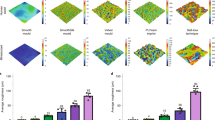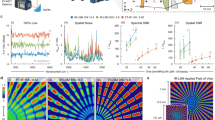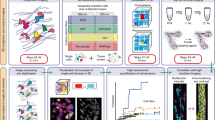Abstract
Between 1 and 2 million women in the United States have silicone breast implants. Complications include capsular contracture and calcification and possibly connective tissue diseases such as scleroderma and rheumatoid arthritis, a subject of some controversy1–7. In order to accurately assess the role of silicone in any histopathologic change, it is necessary to confirm its presence and to identify other foreign materials in the capsular tissue. Although light microscopy is used to visualize regions of tissue containing foreign inclusions, their chemical identity can only be determined using analytical techniques such as infrared or Raman microscopy. However, these conventional microprobe techniques record spectra only at single points and require an a priori knowledge of the locations of the inclusion to be probed. To significantly extend the capabilities of both infrared spectroscopy and optical microscopy, we have developed a new infrared imaging system that completely integrates these two methods. In this manuscript we highlight the ability of the technique to screen rapidly and to determine accurately the presence, size and chemical composition of silicone gel inclusions in human breast tissue.
This is a preview of subscription content, access via your institution
Access options
Subscribe to this journal
Receive 12 print issues and online access
$259.00 per year
only $21.58 per issue
Buy this article
- Purchase on SpringerLink
- Instant access to full article PDF
Prices may be subject to local taxes which are calculated during checkout
Similar content being viewed by others
References
Bridges, A.J., Conley, C. & Wang, G. A clinical and immunologic evaluation of women with silicone breast implants and symptoms of rheumatic disease. Ann. Intern. Med. 118, 929–937 (1993).
Dugowson, C.E., Daling, J., Koepsell, T.D., Voigt, L. & Nelson, J.L. Silicone breast implants and risk for rheumatoid arthritis. Arthritis Rheum. 35 (Suppl.), S66 (1992).
Hochberg, M.C. et al. The association of augmentation mammoplasty with systemic sclerosis: Preliminary results from a case-control study. Arthritis Rheum. 36 (Suppl.), S71 (1993).
Gabriel, S.E., Melton, L.J. Woods, J.E. O'Fallon, W.M. & Kuriand, L.T. Silicone-containing implants and connective tissue diseases: A population-based retrospective cohort study. Arthritis Rheum. 36 (Suppl.), S70 (1993).
Gabriel, S.E. et al. Risk of connective-tissue diseases and other disorders after breast implantation. N. Engl. J. Med. 330, 1697–1702 (1994).
Sanchez-Guerrero, J. et al. Silicone breast implants and the risk of connective-tissue diseases and symptoms. N. Engl. J. Med. 332, 1666–1670 (1995).
Hennekens, C.H. et al. Self-reported breast implants and connective-tissue diseases in female health professionals. J. Am. Med. Assoc. 275, 616–621 (1996).
Peters, W. et al. Analysis of silicon levels in capsules of gel and saline breast implants and of penile prostheses. Ann. Plast. Surg. 34, 578–584 (1995).
Schaeberle, M.D. et al. Raman chemical imaging: Histopathology of inclusions in human breast tissue. Anal. Chem. 68, 1829–1833 (1996).
Frank, C.J. McCreery, R.L. Redd, D.C. & Gansler, T.S. Detection of silicone in lymph node biopsy specimens by near-infrared Raman spectroscopy. Appl. Spectrosc. 47, 387–390 (1993).
Hardt, N.S., Yu, L.T., La Torre, G. & Steinbach, B. Fourier transform infrared microspectroscopy used to identify foreign materials related to breast implants. Mod. Pathol. 7, 669–676 (1994).
Centano, J.A. & Johnson, F.B. Microscopic identification of silicone in human breast tissues by infrared microspectroscopy and X-ray analysis. Appl. Spectrosc. 47, 341–345 (1993).
Levin, I.W. Vibrational spectroscopy of membrane assemblies. in Advances in Raman and Infrared Spectroscopy. Vol. 11. (ed. Clark, R. J. H. & Hester, R. E.) 1–48 (Wiley-Heyden, New York, 1983).
Parker, F.S. Applications of Infrared, Raman, and Resonance Raman Spectroscopy in Biochemistry (Plenum, New York, 1983).
Lewis, E.N. et al. Fourier transform spectroscopic imaging using an infrared focal-plane array detector. Anal. Chem. 67, 3377–3381 (1995).
Goldstein, S.R., Kidder, L.H., Herne, T.M., Levin, I.W. & Lewis, E.N. The design and implementation of a high fidelity Raman imaging microscope. J. Microsc. (in the press).
Morris M.D. (ed.) Microscopic and Spectroscopic Imaging of the Chemical State (Marcel Dekker, New York, 1993).
Lewis, E.N., Levin, I.W. & Treado, P.J. Spectroscopic imaging device employing imaging quality spectral filters. U.S. Patent 5, 377–003, December, 1994.
Author information
Authors and Affiliations
Rights and permissions
About this article
Cite this article
Kidder, L., Kalasinsky, V., Luke, J. et al. Visualization of silicone gel in human breast tissue using new infrared imaging spectroscopy. Nat Med 3, 235–237 (1997). https://doi.org/10.1038/nm0297-235
Received:
Accepted:
Issue date:
DOI: https://doi.org/10.1038/nm0297-235
This article is cited by
-
Adaptive real-time dual-comb spectroscopy
Nature Communications (2014)
-
Towards a practical Fourier transform infrared chemical imaging protocol for cancer histopathology
Analytical and Bioanalytical Chemistry (2007)
-
Delimitation of squamous cell cervical carcinoma using infrared microspectroscopic imaging
Analytical and Bioanalytical Chemistry (2006)
-
A Primer on the Analytical Aspects of Silicones at Trace Levels-Challenges and Artifacts – A Review
Silicon Chemistry (2006)
-
Infrared spectroscopic imaging for histopathologic recognition
Nature Biotechnology (2005)



